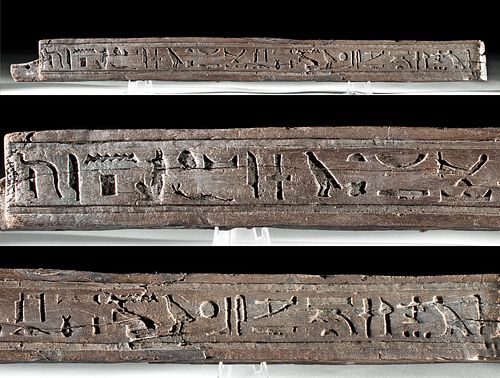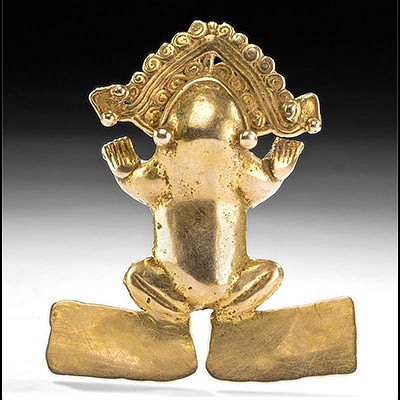Translated Egyptian Wooden Coffin Panel Fragment
Lot 10
About Seller
Artemis Fine Arts
686 S Taylor Ave, Ste 106
Louisville, CO 80027
United States
Selling antiquities, ancient and ethnographic art online since 1993, Artemis Gallery specializes in Classical Antiquities (Egyptian, Greek, Roman, Near Eastern), Asian, Pre-Columbian, African / Tribal / Oceanographic art. Our extensive inventory includes pottery, stone, metal, wood, glass and textil...Read more
Categories
Estimate:
$2,500 - $4,000
Absentee vs Live bid
Two ways to bid:
- Leave a max absentee bid and the platform will bid on your behalf up to your maximum bid during the live auction.
- Bid live during the auction and your bids will be submitted real-time to the auctioneer.
Bid Increments
| Price | Bid Increment |
|---|---|
| $0 | $25 |
| $300 | $50 |
| $1,000 | $100 |
| $2,000 | $250 |
| $5,000 | $500 |
| $10,000 | $1,000 |
| $20,000 | $2,500 |
| $50,000 | $5,000 |
| $100,000 | $10,000 |
| $200,000 | $20,000 |
About Auction
By Artemis Fine Arts
Aug 13, 2020
Set Reminder
2020-08-13 10:00:00
2020-08-13 10:00:00
America/New_York
Bidsquare
Bidsquare : Fine Antiquities, Ethnographic & Fine Art
https://www.bidsquare.com/auctions/artemis-gallery/fine-antiquities-ethnographic-fine-art-5415
Features classical antiquities, ancient and ethnographic art from cultures encompassing the globe. Egyptian, Greek, Roman, Etruscan, Near Eastern, Asian, Pre-Columbian, Native American, African / Tribal, Oceanic, Spanish Colonial, Russian, Fine Art, so much more! Artemis Fine Arts info@artemisgallery.com
Features classical antiquities, ancient and ethnographic art from cultures encompassing the globe. Egyptian, Greek, Roman, Etruscan, Near Eastern, Asian, Pre-Columbian, Native American, African / Tribal, Oceanic, Spanish Colonial, Russian, Fine Art, so much more! Artemis Fine Arts info@artemisgallery.com
- Lot Description
Ancient Egypt, Late Dynastic to Ptolemaic Period, ca. 664 to 30 BCE. A wonderful hardwood panel fragment from a Late Period coffin exhibiting an inscribed hieroglyphic register which contains a partial prayer to the deceased. The rectangular panel has a partial tenon on one side with a perforation meant to receive a dowel, and a pair of incised bars encloses the hieroglyphs. The hieroglyphs are read left to right in this case and when translated state, "Recitation by [the deities] Anubis, who is both on top of his mountain and in the place of embalming, [and by] Osiris who is in charge of the funerary bier . . . When they both shine upon Egypt [on behalf of] the overseer of foremen of the craftsmen in . . ." Lucite display stands for photography purposes only. Size: 26.125" L x 2.3" W (66.4 cm x 5.8 cm)
Anthropoid coffins first appeared during the Middle Kingdom era - skillfully carved so as to outline the mummy's body and decorated with the visage and wig of the deceased individual. Such coffins not only served to copy the mummy's form kept within, but also as actual substitutes for the bodies in the event that the body of the deceased was lost or destroyed. As time progressed, these coffins were decorated with more extensive iconographic and hieroglyphic programs, presenting a greater number of inscriptions as we see in this example.
Provenance: ex-private New York, New York, USA collection; ex-Pasha Khabasha collection, dispersed prior to 1970
All items legal to buy/sell under U.S. Statute covering cultural patrimony Code 2600, CHAPTER 14, and are guaranteed to be as described or your money back.
A Certificate of Authenticity will accompany all winning bids.
We ship worldwide and handle all shipping in-house for your convenience.
#156456This is a fragment of a larger coffin panel. Repaired from two large pieces, with small chips and light adhesive residue along break lines. Partial loss to tenon as shown. Abrasions and a few stable fissures across body and peripheries, with very light encrustations within some hieroglyphs. Great patina throughout. Hieroglyphs are still legible.Condition
- Shipping Info
-
All shipping is handled in-house for your convenience. Your invoice from Artemis Gallery will include shipping calculation instructions. If in doubt, please inquire BEFORE bidding for estimated shipping costs for individual items.
-
- Buyer's Premium



 EUR
EUR CAD
CAD AUD
AUD GBP
GBP MXN
MXN HKD
HKD CNY
CNY MYR
MYR SEK
SEK SGD
SGD CHF
CHF THB
THB














